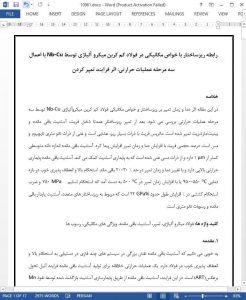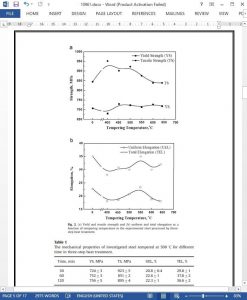Abstract
We describe here the impact of tempering temperature and tempering time on the microstructure and mechanical property in a low carbon Nb–Cu microalloyed steel via a three-step heat treatment. After tempering process, the microstructure primarily comprised of ferrite, retained austenite and tempered bainite/martensite. The ferrite matrix with ultrafine grain size was film-like and enriched with nanometer-sized niobium-containing and copper precipitates. The volume fraction of ferrite increased with the increase in tempering temperature and tempering time. Retained austenite had average grain size less than 1 μm and was enriched with copper precipitates that contributes to enhance the stability of austenite. The retained austenite revealed high thermal stability and remained stable in the range of 20–30% when tempering temperature and time changed. High strength and good ductility were obtained in the tempering temperature range of 450–550 °C, or by prolonging tempering time at 500 °C, where the yield strength was ~750 MPa and the product of tensile strength and % elongation was ~32 GPa%, which is attributed to the cooperation of multiphase microstructure, stable retained austenite and nanometer-sized precipitates.
1. Introduction
It is well known that retained austenite plays a great role in a multiphase system to obtain high strength and excellent ductility in steel. One promising and innovative heat treatments for the creation of retained austenite is annealing reverted transformation process (ART) [1–4]. In this process, retained austenite was obtained by the stabilization of reverted austenite through the diffusion of Mn or Ni from nearby martensite during the intercritical annealing process in high Mn/Ni martensitic steels.
5. Conclusions
In the present study, a three-step heat treatment was considered to obtain superior mechanical properties in a low carbon microalloyed steel. The present study focused on the impact of third-step tempering process on the structure–mechanical property relationship. In addition, the impact of nanometer-sized precipitates and retained austenite were discussed. The primary conclusions are as follows:
(1) The microstructure of the three-step processed steel comprised of ferrite, retained austenite and tempered bainite/ martensite. Ferrite was enriched with niobium-containing and copper precipitates, and ferrite content increased with increase in tempering temperature and time.
(2) Retained austenite has ultrafine size less than 1 μm, and was enriched with copper precipitates that contribute to enhance the stability of austenite. The volume fraction of retained austenite remained stable between 20% and 30%, showing high thermal stability during the tempering process.
(3) The combination of ultrafine microstructure, retained austenite and nanometer-sized precipitates led to superior mechanical properties: yield strength of 700–750 MPa, and tensile strength of 850–930 MPa, uniform elongation of 20–23%, and total elongation of 30–38%. This is attributed to the cooperation of TRIP effect of retained austenite and precipitation strengthening effect of nanometer-sized precipitates.
(4) The optimal combination of high strength and good ductility was obtained in tempering temperature range of 450–500 1C or by prolonging the tempering time at 500 1C, such that the product of tensile strength and total elongation was greater than 32 GPa%.











